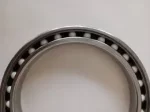Characteristics of different types of bearings and applicable scenarios
Introduction
Bearings play a crucial role in various industries by enabling smooth rotation and movement of machinery components. Different types of bearings are designed to meet specific requirements based on factors such as load capacity, rotational speed, operating conditions, and environmental factors. This article aims to discuss the characteristics of different types of bearings and their applicable scenarios.
1. Deep Groove Ball Bearings
Deep groove ball bearings are the most common type of bearings, known for their versatility and wide range of applications. They consist of an inner ring, an outer ring, a cage, and a series of balls. The main characteristics of deep groove ball bearings include:
- High radial and axial load capacity.
- Low friction and excellent rotational performance.
- Suitable for high-speed applications.
- Commonly used in electric motors, automotive transmissions, and household appliances.
2. Thrust Bearings
Thrust bearings are specifically designed to handle axial loads, i.e., loads parallel to the shaft’s axis. They differ from other types of bearings in terms of their shape and arrangement. Some key features of thrust bearings are:
- High load-carrying capacity in a particular direction.
- Minimal space requirement due to their compact design.
- Prevent shaft misalignment and provide smooth thrust motion.
- Commonly used in automotive transmissions, marine propellers, and aerospace applications.
3. Tapered Roller Bearings
Tapered roller bearings consist of a cone assembly and a cup assembly, allowing for efficient transfer of radial and axial loads. They can accommodate both thrust and radial forces simultaneously. Here are some notable characteristics of tapered roller bearings:
- High radial and axial load capacity.
- Ability to withstand high temperatures and shock loads.
- Provide accurate shaft alignment and reduce friction.
- Often used in wheel hubs, gearboxes, and heavy machinery.
4. Spherical Roller Bearings
Spherical roller bearings are designed to accommodate heavy radial loads and misalignment. Their outer ring has a spherical raceway, enabling self-alignment. The key features of spherical roller bearings are:
- High radial load capacity.
- Compensate for misalignment caused by shaft deflection or mounting errors.
- Durable and suitable for harsh operating conditions.
- Commonly used in mining equipment, paper mills, and steel rolling mills.
Conclusion
In conclusion, different types of bearings have distinct characteristics that make them suitable for specific applications. Deep groove ball bearings are versatile and widely used, while thrust bearings excel at handling axial loads. Tapered roller bearings provide efficient load transfer, and spherical roller bearings accommodate heavy radial loads and misalignment. Understanding the characteristics of different bearings allows engineers and industry professionals to select the most suitable type for their specific application, ensuring optimal performance and longevity of the machinery.
.webp)
